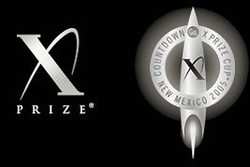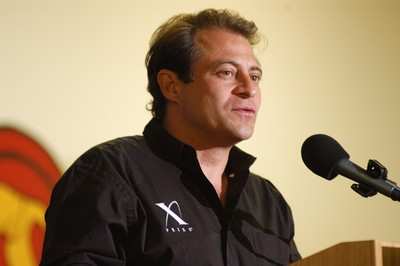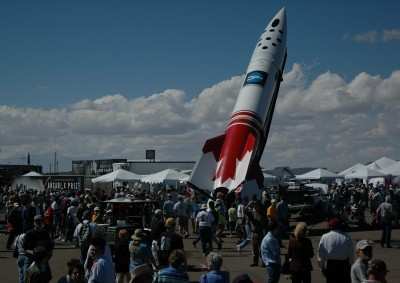 The X PRIZE Foundation
and the Spaceward Foundation have signed an agreement that will
bring the Space Elevator Games, a NASA Centennial Challenge, to the
2006 X PRIZE Cup in Las Cruces, New Mexico. More than 20 teams are
expected to compete for $400,000 at the Las Cruces International
Airport on October 20-21, 2006.
The X PRIZE Foundation
and the Spaceward Foundation have signed an agreement that will
bring the Space Elevator Games, a NASA Centennial Challenge, to the
2006 X PRIZE Cup in Las Cruces, New Mexico. More than 20 teams are
expected to compete for $400,000 at the Las Cruces International
Airport on October 20-21, 2006.
"We are very excited to welcome the Elevator Games to the X
PRIZE Cup." Said X PRIZE Founder and Chairman Dr. Peter H.
Diamandis (pictured, below).
"Each year, we will bring together the most exciting spectator
events and competitions in the space industry and this agreement
with the Spaceward Foundation is a great step towards accomplishing
our goal."
The Space Elevator is a revolutionary space transportation
system based on a ribbon that extends from a ship-borne anchor to a
counterweight well beyond geo-synchronous orbit. The ribbon is kept
taut due to the rotation of the earth (and that of the
counterweight around the earth). Electric vehicles, called
climbers, ascend the ribbon using electricity generated by solar
panels lit by a ground-based high-power beam of light.

The objective of a space elevator is to make access to space
easy, safe, and affordable. At under $100 per pound, the estimated
cost of transporting materials and people to space is 100 times
less expensive than today's method utilizing rockets. Low cost
access to space, and the substantial carrying capacity of one or
more space elevators will allow mankind to reach into space on an
unprecedented scale.
This is the second year for the Space Elevator Games, last
year's competition matched 12 competitors against each other. This
year the competition has heated up to include more than 20
competitors from all over the globe.
The Space Elevator was first proposed in the 1960's by Yuri
Artsutanov, a Russian engineer, as a far-reaching engineering
concept. The scientific principles underlying it are well
understood and all the fundamental materials and technologies
required for construction of an elevator exist today in some form.
The present Space Elevator design was conceived by Dr. Brad Edwards
working in conjunction with NASA's Institute for Advanced Concepts
(NIAC).

"We are thrilled to be working with the X PRIZE foundation for
the second annual Space Elevator Games" said Ben Shelef, Founder of
the Spaceward Foundation. "With an expected attendance of 20,000
people, the X PRIZE CUP venue is a perfect event to showcase and
validate the worlds leading space elevator technologies." This
year's challenge will feature teams from around the world competing
for $400,000 of prize money, and it promises to be a spectacular
competition."
This is the second of the NASA Centennial Challenges to take
place at the X PRIZE Cup. The first, announced in May of 2006, was
the $2m Lunar Lander Challenge. The Lunar Lander Challenge will
take place at the X PRIZE Cup in Las Cruces, New Mexico on October
20-21, 2006. As the world's first space show, the X PRIZE Cup is
the only annual event where the entire family can visit to see the
next generation of spaceships up close and in the sky.
The Spaceward Foundation is a public-funds non-profit
organization dedicated to furthering space science and technology
in education and in the public mindshare. Spaceward Foundation
intends to bring together leaders from the academic, commercial and
educational worlds and create a series of challenges, exhibits, and
educational activities that will re-invigorate the nation's
interest in space.

NASA's Centennial Challenges promotes technical innovation
through a novel program of prize competitions. It is designed to
tap the nation's ingenuity to make revolutionary advances to
support the Vision for Space Exploration and NASA goals. NASA's
Exploration Systems Mission Directorate manages the program.
In 2004, the Ansari X PRIZE proved that offering a prize is an
effective, efficient and economical model for accelerating
breakthroughs in science and technology. Based on that success, the
X PRIZE Foundation is now expanding their efforts to offer more
prizes in the space industry, as well as, in the areas of health,
energy, transportation, and education.
 ANN's Daily Aero-Linx (05.06.25)
ANN's Daily Aero-Linx (05.06.25) ANN's Daily Aero-Term (05.06.25): Ultrahigh Frequency (UHF)
ANN's Daily Aero-Term (05.06.25): Ultrahigh Frequency (UHF) ANN FAQ: Q&A 101
ANN FAQ: Q&A 101 Classic Aero-TV: Virtual Reality Painting--PPG Leverages Technology for Training
Classic Aero-TV: Virtual Reality Painting--PPG Leverages Technology for Training Airborne 05.02.25: Joby Crewed Milestone, Diamond Club, Canadian Pilot Insurance
Airborne 05.02.25: Joby Crewed Milestone, Diamond Club, Canadian Pilot Insurance






